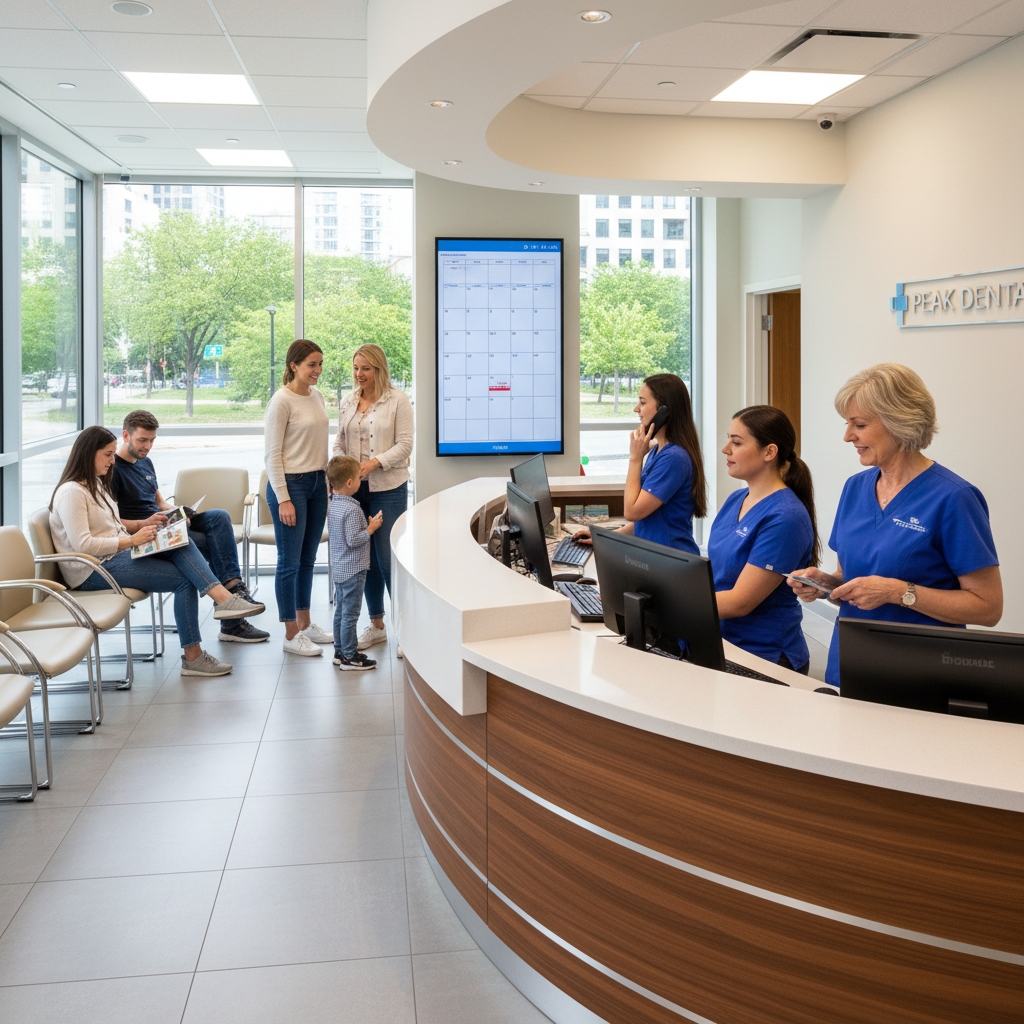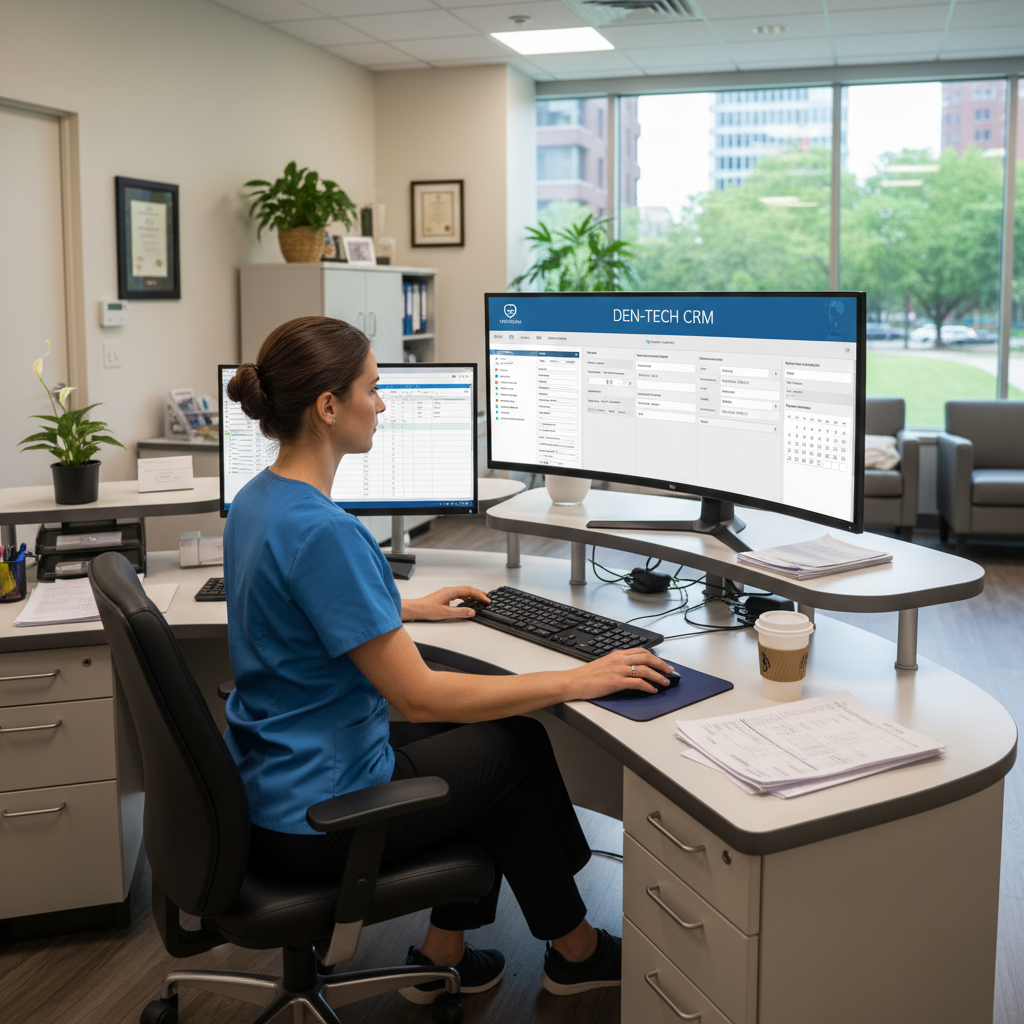












Blog Article


How to Enhance Patient Experience with Empathetic AI Messaging - Guide For Dentists and DSOs
Dental practices lose thousands of dollars every month from missed calls and no-shows, but artificial intelligence can solve these problems while improving patient relationships. Modern dental offices struggle to answer every patient call, schedule appointments efficiently, and maintain consistent communication across multiple locations.
AI-powered messaging systems can reduce no-shows by up to 40% while handling patient inquiries with empathy and accuracy 24 hours a day. Research shows that AI systems can create more caring responses than human staff in many situations, making patients feel heard and valued.
Smart automation handles appointment confirmations, treatment reminders, and frequently asked questions without requiring additional staff time. AI-powered patient engagement platforms allow dental practices and DSOs to scale their communication efforts while maintaining the personal touch that builds patient trust and loyalty.
Key Takeaways
- AI messaging reduces patient no-shows and captures revenue from missed calls by providing 24/7 automated responses
- Empathetic AI systems create more caring patient interactions while freeing staff to focus on clinical work
- Advanced analytics and multi-location integration help DSOs track performance and maintain consistent patient communication
Patient Experience With Empathetic AI Messaging
Empathetic AI messaging transforms how dental practices communicate with patients by delivering personalized, caring responses that match human-like interaction quality. These systems reduce wait times, improve appointment scheduling efficiency, and create consistent communication experiences that build stronger patient relationships.
Benefits Of Human-Like Automated Communication
Natural Language Processing enables AI systems to understand patient concerns and respond with appropriate empathy. Dental practices using conversational AI see patients receive immediate responses to appointment requests, insurance questions, and treatment concerns without waiting for staff availability.
AI messaging systems process patient emotions through text analysis. They detect anxiety in messages about procedures and respond with reassuring language. This machine learning capability helps practices address patient fears before they escalate.
Key advantages include:
- 24/7 availability for patient inquiries
- Consistent tone and messaging across all communications
- Reduced staff workload for routine questions
- Multilingual support for diverse patient populations
Automated systems handle appointment confirmations, reminder messages, and post-treatment follow-ups with personalized details. Patients receive messages that reference their specific treatments, appointment times, and dentist names rather than generic templates.
Studies show that AI-generated healthcare responses receive higher patient satisfaction ratings than traditional communication methods. Patients rate AI responses as more caring and informative compared to rushed human interactions during busy office hours.
AI Messaging Impact On Patient Satisfaction
Patient satisfaction increases when dental practices implement empathetic AI messaging systems. Patients appreciate quick responses to their questions about treatment costs, insurance coverage, and appointment availability without calling during business hours.
AI systems maintain detailed conversation histories. When patients contact the practice multiple times, the system references previous interactions and provides contextual responses. This continuity makes patients feel remembered and valued.
Satisfaction improvements include:
- Faster response times to patient inquiries
- Personalized communication based on treatment history
- Reduced phone hold times and missed calls
- Consistent information across all staff interactions
Artificial intelligence analyzes patient communication patterns to identify satisfaction trends. Practices can track which message types generate positive responses and adjust their communication strategies accordingly.
Patients report feeling more comfortable discussing sensitive topics like payment plans or dental anxiety through AI messaging. The non-judgmental nature of AI communication encourages honest dialogue about treatment concerns.
AI-powered patient engagement platforms deliver measurable satisfaction improvements through personalized communication strategies that adapt to individual patient preferences and communication styles.
Improving Patient Retention With AI Messaging
Patient retention improves significantly when practices use empathetic AI messaging for ongoing communication. AI systems send personalized follow-up messages after treatments, birthday wishes, and preventive care reminders that keep patients engaged with the practice.
Retention strategies through AI messaging focus on proactive communication. Systems identify patients who haven't scheduled appointments in six months and send personalized outreach messages with treatment reminders or special offers.
Retention benefits:
- Automated recall systems for routine cleanings
- Personalized treatment plan reminders
- Birthday and holiday greetings with appointment incentives
- Post-treatment satisfaction surveys with immediate response capabilities
Conversational AI tracks patient engagement levels through message response rates and appointment booking patterns. Practices can identify at-risk patients and implement targeted retention campaigns before patients switch to competitors.
AI messaging handles sensitive retention conversations like discussing overdue payments or missed appointments with diplomatic language. This approach maintains positive relationships while addressing practice management concerns.
Long-term patient relationships strengthen when AI systems remember patient preferences, family member treatments, and communication timing preferences. Patients develop loyalty to practices that demonstrate consistent attention to their individual needs through personalized messaging experiences.
Missed Calls And Revenue Loss In Dental Practices
Dental practices face substantial financial losses when calls go unanswered, with studies showing practices missing 30-35% of incoming calls and losing over $100,000 annually per location. The financial impact extends beyond immediate appointment losses to long-term patient relationship damage.
Statistics On Dental Missed Calls
Dental practices consistently struggle with call management challenges that directly impact their bottom line. Research reveals that practices miss approximately 29% of all incoming calls, creating significant gaps in patient communication.
The conversion rates tell an even more concerning story. Of answered calls, only 42% result in actual appointments. This means practices lose 71 potential new patients for every 100 calls received.
Peak hours present the greatest challenges for dental offices. Most missed calls occur during lunch breaks, busy treatment periods, and after-hours when staff availability is limited.
Key Call Statistics:
- 29% of calls go unanswered
- 42% conversion rate for answered calls
- 71 lost opportunities per 100 calls
- Highest miss rates during peak hours
Revenue At Risk From Unanswered Calls
The financial consequences of missed calls create devastating losses for dental practices of all sizes. A practice missing 120 new patient calls annually faces potential revenue losses of $960,000 when each patient has a lifetime value of $8,000.
The long-term impact becomes even more significant. Over 30 years, these losses compound to over $21 million in missed revenue opportunities.
Small and medium-sized practices feel these losses most acutely. Unlike large DSOs with multiple locations to offset losses, smaller practices depend heavily on each new patient acquisition.
Revenue Loss Breakdown:
- Single missed call: $8,000 potential lifetime value
- 120 missed calls annually: $960,000 lost revenue
- 30-year projection: $21+ million total loss
Link Between Missed Calls And Patient Loyalty
Patient expectations have shifted dramatically in the digital age. When potential patients cannot reach a dental office, they rarely attempt a second call and instead move to competitors who answer promptly.
First impressions matter significantly in healthcare. An unanswered call creates immediate doubt about the practice's reliability and patient care standards. Patients interpret missed calls as signs of poor organization or lack of concern for their needs.
Existing patients also experience frustration when they cannot reach their dental office for urgent questions or appointment changes. This leads to decreased satisfaction scores and higher patient churn rates.
The competitive dental market means patients have numerous options. Practices that consistently miss calls lose both new patient acquisitions and existing patient retention to more responsive competitors.
Reducing No-Shows With Automated Follow-Ups
Automated messaging systems can cut dental practice no-show rates by 20% to 60% through strategic reminders and personalized communication. AI-powered appointment reminders help practices maintain consistent patient flow while reducing administrative workload.
AI-Driven Reminders For Appointments
AI messaging systems send personalized reminders at optimal times to maximize patient attendance. The most effective approach includes three touchpoints: one week before, two days prior, and day-of reminders.
These systems personalize each message with patient names and specific appointment details. They also include preparation instructions for procedures like cleanings or extractions.
Key AI reminder features for dental practices:
- Two-way communication allowing patients to confirm, cancel, or reschedule via text
- Multiple channels including SMS, email, and voice calls
- 24/7 availability for patient responses outside office hours
- Integration with practice management software
AI systems adapt messaging tone based on appointment type. Routine cleaning reminders use friendly language, while surgical procedure messages include calming information to reduce anxiety.
The technology handles high-volume reminder campaigns without staff intervention. This frees dental teams to focus on patient care rather than phone calls.
Data On Lowering No-Shows In Dentistry
Research shows automated reminders reduce no-shows by 38% when using text messages alone. Multi-channel approaches achieve even better results.
Dental practices report significant improvements after implementing automated systems. El Rio Health reduced no-show rates by 32% and increased monthly revenue by $100,000 using AI-powered reminders.
No-show reduction statistics:
Reminder Method Reduction Rate
Text messages only 38%
Multi-channel reminders 20-60%
AI-powered systems Up to 60%
Timing plays a crucial role in reminder effectiveness. Studies indicate that two text message reminders reduce no-shows by 7% and same-day cancellations by 6%.
The average dental appointment no-show costs practices approximately $200 in lost revenue. For a practice with 50 weekly appointments and an 18% no-show rate, automated reminders can save over $18,000 monthly.
Improving Attendance And Retention
Automated follow-ups extend beyond appointment reminders to build stronger patient relationships. Post-appointment messages maintain engagement and encourage return visits for ongoing care.
These systems send care instructions after procedures, check on patient recovery, and schedule follow-up appointments automatically. They also request feedback through simple surveys to monitor satisfaction levels.
Follow-up message types:
- Post-treatment care instructions
- Recovery check-ins after extractions or surgeries
- Preventive care reminders for cleanings
- Treatment plan continuation messages
Personalized messaging makes patients feel valued and informed about their oral health. Holiday greetings and educational content through newsletters strengthen the patient-practice relationship.
Patient retention improves when practices maintain consistent communication between visits. Automated systems track patient preferences and send targeted messages about services like teeth whitening or orthodontic consultations.
The technology identifies patients at risk of missing appointments based on attendance history and demographic factors. High-risk patients receive additional reminders and telehealth consultation options to maintain their care schedule.
24×7 Virtual Receptionist For Dental Offices
AI dental receptionists provide continuous patient support without the limitations of traditional staffing. These systems handle appointment booking, emergency calls, and patient inquiries around the clock while reducing operational costs.
Round-The-Clock Coverage For Patient Calls
Dental practices lose potential patients when calls go unanswered after hours. A virtual receptionist ensures every patient inquiry receives immediate attention, regardless of the time.
These AI systems work 365 days a year without breaks or sick days. Patients can call at midnight on weekends and still receive professional responses about their dental concerns.
Key benefits include:
- No missed emergency calls during off-hours
- Immediate response to urgent dental pain inquiries
- Consistent professional communication at all times
- Reduced patient frustration from unanswered calls
Emergency dental situations often occur outside business hours. Virtual receptionists can assess urgency levels and provide appropriate guidance or connect patients with on-call dentists when necessary.
The system maintains the same level of care whether patients call at 2 PM or 2 AM. This consistency builds trust and demonstrates the practice's commitment to patient welfare.
Overflow And After-Hours Call Handling
High call volumes during peak hours can overwhelm front desk staff. Virtual receptionists handle overflow calls seamlessly while human staff focuses on in-person patients.
During busy periods, the AI system takes additional calls without putting patients on hold. This prevents frustrated callers from hanging up and potentially choosing competitor practices.
Overflow management features:
- Automatic call routing when lines are busy
- Queue management for multiple simultaneous calls
- Priority handling for existing patient emergencies
- Integration with existing phone systems
After-hours call handling becomes particularly valuable for DSOs managing multiple locations. A single virtual system can serve all practice locations during evenings and weekends.
The AI maintains detailed call logs and patient information for staff review the next business day. This ensures continuity of care and proper follow-up on all patient interactions.
Seamless Appointment Booking And Scheduling
Voice assistants integrated into virtual receptionist systems allow patients to book appointments through natural conversation. The technology accesses real-time calendar availability across multiple providers and treatment types.
Appointment scheduling capabilities:
Feature Benefit
Real-time availability Instant booking confirmation
Multi-provider calendars Optimal scheduling efficiency
Treatment-specific slots Proper time allocation
Automatic confirmations Reduced no-shows
The system handles complex scheduling scenarios like recurring appointments and multi-visit treatment plans. Patients can reschedule or cancel appointments without waiting for business hours.
Integration with practice management software ensures all bookings sync automatically. This eliminates double-booking risks and maintains accurate patient records.
Advanced appointment scheduling systems can also send automated reminders and handle insurance verification during the booking process. This reduces administrative burden on human staff while improving patient preparation for visits.
Analytics Dashboard For Dental Performance
Modern dental practices need real-time visibility into call patterns, revenue sources, and staff productivity to optimize patient acquisition and retention. Advanced dental practice analytics software provides actionable insights that directly impact practice growth and patient satisfaction metrics.
Tracking Missed-Call Heatmaps
Missed calls represent lost revenue opportunities that many dental practices fail to quantify properly. Heat map analytics reveal peak calling times when staff capacity becomes overwhelmed.
These visual representations show hour-by-hour and day-by-day patterns of incoming calls versus answered calls. Practices typically lose 20-30% of potential appointments due to unanswered phones during busy periods.
Key metrics to monitor include:
- Peak call volume windows (usually 8-10 AM and 2-4 PM)
- Staff availability during high-demand periods
- Callback response times for missed opportunities
- Conversion rates from returned calls to scheduled appointments
Heat map data helps practices adjust staffing schedules and implement backup call handling systems. Dental support organizations can identify underperforming locations by comparing missed-call patterns across multiple practices.
The analytics reveal seasonal trends and appointment cancellation impacts on call volume spikes. Practices using this data typically see 15-25% improvement in call answer rates within 60 days.
Revenue Attribution Analytics
Understanding which marketing channels and patient touchpoints generate the highest-value appointments drives smarter budget allocation decisions. Revenue attribution connects patient acquisition costs to lifetime value metrics.
Dental analytics dashboards track patient journeys from initial contact through treatment completion. This data shows which referral sources produce patients who accept comprehensive treatment plans.
Critical revenue metrics include:
- Average case value by acquisition channel
- Treatment acceptance rates per patient source
- Insurance versus cash patient profitability
- Referral patient lifetime value compared to new patient marketing
Multi-location practices need standardized attribution models to compare performance across sites. The data reveals which locations excel at converting consultations into high-value treatments.
Seasonal revenue patterns help practices prepare for slower periods and capitalize on peak demand months. Practices using attribution analytics typically increase revenue per patient by 18-30% within one year.
Staff Follow-Up Monitoring And Metrics
Patient follow-up consistency directly impacts treatment acceptance rates and practice reputation scores. Automated tracking systems monitor staff compliance with established follow-up protocols.
The dashboard tracks appointment confirmation calls, treatment plan discussions, and post-visit care communications. Staff members receive real-time feedback on their follow-up completion rates.
Essential follow-up metrics include:
- Appointment confirmation response rates
- Treatment plan follow-up completion within 48 hours
- Post-treatment satisfaction call completion
- Reactivation campaign success rates for inactive patients
Individual staff performance dashboards create accountability while identifying training opportunities. High-performing team members can mentor others using proven follow-up scripts and timing strategies.
Automated alerts notify managers when follow-up tasks remain incomplete beyond established timeframes. Practices with consistent follow-up protocols see 25-40% higher treatment acceptance rates and improved online review scores.
The system integrates with practice management software to eliminate duplicate data entry and ensure seamless workflow management.
Multi-Location Roll-Outs And Custom Integrations
Dental service organizations need specialized deployment strategies and seamless software integration across multiple practice locations. Custom solutions allow for branded patient communications while maintaining consistent messaging standards.
White-Label Solutions For DSOs
White-label AI messaging platforms allow DSOs to maintain their brand identity across all locations. These solutions remove vendor branding and incorporate custom logos, colors, and practice-specific messaging.
Most platforms offer customizable templates that align with existing brand guidelines. DSOs can create standardized response protocols while allowing individual practices to personalize certain aspects of patient communication.
Implementation typically takes 2-4 weeks per location. The platform administrator can control messaging consistency from a central dashboard while giving practice managers limited customization access.
Key Benefits:
- Consistent brand experience across locations
- Centralized management with local flexibility
- Reduced training time for staff
- Unified reporting and analytics
Integration Directly Into Practice Management Systems
Modern AI messaging solutions integrate with popular dental practice management software like Dentrix, Eaglesoft, and Open Dental. These integrations eliminate double data entry and sync patient information automatically.
Direct integration allows the AI to access appointment schedules, treatment plans, and patient histories. This creates more personalized and accurate responses to patient inquiries.
The integration process involves API connections that typically require IT support. Most vendors provide dedicated implementation specialists to ensure smooth data flow between systems.
Common Integration Features:
- Automatic appointment scheduling
- Treatment reminder customization
- Insurance verification workflows
- Patient portal connectivity
Healthcare organizations implementing AI solutions require strategic planning and technical expertise for successful deployment.
Scalability For Multiple Dental Clinics
Scalable AI messaging platforms accommodate growing DSO networks without performance degradation. Cloud-based infrastructure automatically adjusts to handle increased patient volume across multiple locations.
Most enterprise solutions offer tiered pricing based on the number of active patients or locations. This allows DSOs to add new practices without major system overhauls or significant cost increases.
Standardized patient communication strategies help healthcare groups maintain consistency while expanding operations.
Scalability Considerations:
Factor Single Practice Multi-Location DSO
Setup Time 1-2 weeks 4-8 weeks
Training Required Minimal Comprehensive
Cost Structure Fixed monthly Volume-based
Customization High Standardized
Advanced platforms provide role-based access controls that allow regional managers to oversee multiple locations while restricting individual practice access to their specific data and settings.
Resonate: AI-Native Patient Engagement Platform
Resonate offers dental practices automated messaging systems that convert missed calls into scheduled appointments. The platform uses intelligent chatbots and analytics to help practices capture more patients and improve operational efficiency.
AI Receptionist For Dentists And DSOs
Dental practices lose approximately 30% of incoming calls when staff members are busy with patients or after-hours situations occur. Resonate AI instantly texts missed callers with personalized messages that feel natural and human-like.
The AI receptionist operates 24/7 without breaks or sick days. It responds to missed calls within seconds using pre-programmed templates that match each practice's tone and branding.
Key features include:
- Automatic missed call detection
- Immediate text message responses
- Customizable message templates
- Integration with existing phone systems
The system generates measurable results for practices. Dental offices using this technology report capturing 174+ new patients monthly with significant return on investment rates.
Context-Aware Chatbots For Scheduling
Smart chatbots handle appointment scheduling through text conversations that feel natural to patients. These systems understand common dental appointment requests and guide patients through the booking process step-by-step.
The chatbots access real-time calendar information to offer available appointment slots. They can handle routine scheduling tasks like cleanings, consultations, and follow-up visits without human intervention.
Scheduling capabilities:
- Real-time appointment availability
- Automatic calendar integration
- Patient information collection
- Appointment confirmation reminders
Patients receive immediate responses to their scheduling requests rather than waiting for office hours. This speed advantage helps practices secure more appointments since 78% of patients book with the first practice that responds.
Comprehensive Dental Analytics Tools
The platform tracks detailed metrics about patient communication patterns and appointment conversion rates. Practice owners can view dashboards showing which messages generate the most responses and bookings.
Analytics reveal peak calling times, common patient questions, and conversion rates from initial contact to scheduled appointments. This data helps practices optimize their communication strategies and staffing schedules.
Analytics features:
- Call volume tracking
- Message response rates
- Appointment conversion metrics
- Patient engagement insights
DSOs benefit from consolidated reporting across multiple locations. They can compare performance between practices and identify best practices for patient communication and scheduling efficiency.
Frequently Asked Questions
Dental practices and DSOs implementing AI messaging systems need clear guidance on personalization, security, emotional intelligence, and staff training. These practical considerations determine the success of empathetic AI communication in dental settings.
What strategies can be implemented to personalize AI messaging for different patient needs?
AI systems can analyze patient demographics, appointment history, and treatment patterns to customize messaging tone and content. Pediatric patients receive playful, encouraging messages while adult orthodontic patients get professional progress updates.
Language preferences and cultural backgrounds shape message personalization. Spanish-speaking patients automatically receive bilingual communications that respect cultural communication styles.
Appointment types trigger specific messaging sequences. Root canal patients receive anxiety-reducing messages with comfort tips, while routine cleaning patients get standard confirmation texts.
Personalized care approaches adapt messaging frequency based on patient preferences stored in practice management systems.
How can we ensure the confidentiality and security of patient information in AI-driven communications?
HIPAA compliance requires encrypted data transmission and secure storage protocols for all AI messaging platforms. Patient health information must remain protected during automated conversations and follow-up sequences.
Role-based access controls limit which staff members can view AI conversation logs. Practice administrators set permission levels for different team roles accessing patient communication data.
Data retention policies automatically delete sensitive conversation histories after specified timeframes. Regular security audits verify AI systems meet healthcare privacy standards.
Third-party AI vendors must sign business associate agreements covering data protection responsibilities. Healthcare organizations integrate conversational AI with existing security frameworks to maintain compliance standards.
What measures can be integrated into AI systems to understand and respond to patient emotions effectively?
Natural language processing identifies emotional indicators in patient messages like anxiety, frustration, or confusion. AI systems adjust response tone from clinical to reassuring based on detected emotional states.
Keyword recognition triggers empathetic responses for sensitive topics. Messages mentioning "pain," "scared," or "worried" activate specialized comfort-focused reply templates.
Escalation protocols automatically flag highly emotional conversations for human staff intervention. Urgent emotional distress bypasses AI systems entirely, routing directly to dental team members.
Voice tone analysis in phone-based AI systems detects stress levels through speech patterns. The system responds with calmer pacing and supportive language when anxiety is detected.
In what ways can AI messaging facilitate timely and efficient patient follow-ups?
Automated appointment reminders send 48 hours, 24 hours, and 2 hours before scheduled visits. No-show rates decrease when patients receive multiple touchpoints through their preferred communication channels.
Post-treatment care instructions deploy immediately after procedures. Extraction patients receive ice pack reminders, pain management guidance, and healing timeline expectations without staff intervention.
Medication adherence reminders help patients maintain antibiotic schedules following dental procedures. Customized timing matches prescription instructions stored in patient records.
AI chatbots make patient communication more efficient by handling routine follow-up questions about healing progress and post-operative symptoms.
How can dental staff be trained to effectively use AI messaging systems to enhance the patient experience?
Hands-on training sessions teach staff to customize AI message templates for different procedure types. Team members learn to adjust automated sequences based on patient feedback and outcomes.
Role-playing exercises help staff understand when to override AI responses with personal communication. Complex treatment planning discussions require human expertise beyond AI capabilities.
Regular review meetings analyze AI conversation logs to identify improvement opportunities. Staff discuss challenging patient interactions and refine AI response protocols accordingly.
Documentation training ensures staff properly record AI interaction outcomes in patient charts. Comprehensive records maintain continuity between automated and human communications.
What are the best practices for integrating empathetic AI messaging within existing dental practice management software?
API integrations synchronize patient data between practice management systems and AI messaging platforms. Appointment schedules, treatment plans, and patient preferences automatically populate AI databases.
Workflow mapping identifies optimal points for AI message deployment throughout patient journeys. Pre-appointment confirmations, post-treatment care, and recall reminders integrate seamlessly into existing protocols.
Testing phases validate AI message accuracy against patient records before full deployment. Small patient groups participate in pilot programs to refine messaging content and timing.
Staff feedback loops allow continuous refinement of AI messaging protocols. Regular system updates incorporate new empathetic language patterns and improved emotional recognition capabilities.
Similar Articles
Ready to Get Started
Have Questions?
We're Here to Help
Connect with our team for personalized guidance
No setup fees, cancel anytime.
.avif)


.svg)
.svg)





